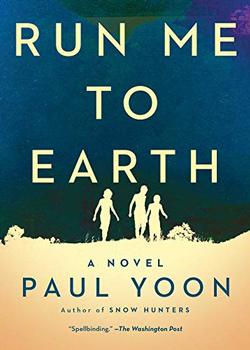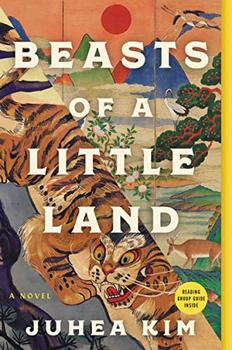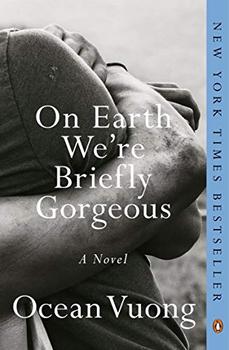Summary | Excerpt | Reading Guide | Reviews | Beyond the book | Read-Alikes | Genres & Themes | Author Bio

Suspenseful and elegant storytelling in Run Me to Earth kept me turning pages even through traumatic and heartbreaking scenes. In the United States, it's a lesser known historical fact—despite American involvement—that the country of Laos was heavily bombarded from 1964 to 1973 during a complicated power conflict in Southeast Asia. In an author's note, Paul Yoon explains the magnitude of devastation: "...the equivalent of one bombardment every eight minutes, twenty-four hours a day, for nine years." His ambitious novel excavates this chapter of Lao history and explores how ordinary civilians cope with war's disruption and violence.
Three orphaned youth—Prany, his sister Noi and their best friend Alisak—exist in the margins, dodging bombs and scavenging to survive. They're recruited by a physician named Dr. Vang and a cadre of nurses who run a makeshift medical clinic in a ruined mansion once owned by a French tobacco planter. At the time, the traditional Lao Royal Government (supported by clandestine United States military forces) is engaged in a civil war against the Communist Pathet Lao, which is allied with the North Vietnamese army. Civilians do what they need to do to survive, and alliances sometimes switch depending on which forces are in control of a particular region. At one point, the Americans bombard land adjacent to the clinic, and Prany wonders why they're trying to "destroy their own side." Prany, like most of the characters in the novel, does not fully understand the absurdity of the war, only existing in a small sphere of opportunity and risk. Landmines and unexploded "bombies" hide everywhere; safe routes have been staked out, but explosions are omnipresent. The nurses send the three teens out on motorbikes to find supplies or transport injured victims through war-scarred terrain.
In exchange for running errands for the clinic, they gain temporary living quarters and some cash. The farmhouse offers a vantage point across the Plain of Jars (a site of megalithic rock formations) that's become a killing field of aerial bombardment. While on lookout duty, or during rest times, the friends play a game imagining elsewhere:
Where did they go at nights? A museum or Paris. The moon. A cave, an endless beach. They had been doing this since they were children.
The book is organized in sections and spans decades. Omniscient narration allows focus to vary among a vivid cast of characters. Stream-of-consciousness prose often reveals the characters' inner worlds, as from Alisak's perspective here:
He was good at driving. Knew the bike now, he thought, better than he knew himself. Knew how it turned or sped or hesitated and groaned. He could pick up a farmer who had lost his legs faster than anyone, slip him behind, hold on to his arms as they raced back to the hospital before the man bled out.
Yoon crafts a careful, often poetic exploration of trauma and death, even in the midst of a harrowing, surreal motorcycle ride through mud and bombs toward a helicopter evacuation site when Noi, driving fast with a nurse riding behind her, makes eye contact with Alisak:
And then she found him, looking back at her, and she focused on him, his face, which carried an expression she wasn't certain of, but which seemed to her, in that moment, like the greatest gift, like something wonderful and old, as though, like some unrecognized promise, they had been given a chance, all of them together, to become old. And as Noi let go of the handlebars and the nurse leaned into her, screaming, it was, just then, in all that sudden, immense quiet, enough.
Fate eventually casts the three young friends in different directions. Each takes actions that cannot be easily categorized as "good" or "evil." Another major character, Auntie (a nom de guerre), is a trader and secret emissary between the Americans and Royal Lao loyalists. She and Dr. Vang were childhood sweethearts, but war has cast them apart, and they remain connected only by secret supply routes and memories. Auntie has the power to make something from nothing, in small ways. She collects drops of rainwater and scraps of food. She sews rags into new garments:
It was easy to find clothes. You took it off the bodies. Or you found them hanging from what was left of the trees. Or they were on the face of a boulder, spread out and weather-faded, as though someone had been in the middle of a wash only to vanish.
Auntie also helps survivors on the run to vanish, to find sanctuary across the border in Thai refugee camps.
The last section of the novel shifts to mountainous and maritime regions of France and Spain. Here, refugees from Laos build new lives. Yoon braids past and present strands of the story together. There's a large farmhouse owned by the same family who once owned the manor-turned-clinic in Laos. Inside the farmhouse is a piano identical to one that Dr. Vang once played in the clinic. The author paints undercurrents of loss and grief just beneath the surface of a picturesque tourist area during peacetime, while also tracing echoes of WWII—when Europe, too, experienced war.
This jump forward to a new century and another continent reminds us, as readers, that war and peace are omnipresent on the planet. Seemingly tranquil and ordinary bike mechanics or shopkeepers or housekeepers may in fact hold extraordinary personal and cultural stories within as they go about daily lives in exile. Yoon reveals snippets of the traumatic past when characters meet and hold conversations about their journeys and survival.
Yoon's powerful storytelling unlocks deeply human themes: childhood interrupted by war, legacies of trauma that burden generations around the globe, cultural endurance, healing, loss, migration. This brilliant rendering of war's lasting impacts provides provocative topics for discussion and literary windows into an underreported segment of history.
![]() This review was originally published in The BookBrowse Review in March 2020, and has been updated for the
February 2021 edition.
Click here to go to this issue.
This review was originally published in The BookBrowse Review in March 2020, and has been updated for the
February 2021 edition.
Click here to go to this issue.

If you liked Run Me to Earth, try these:

by Juhea Kim
Published 2022
An epic story of love, war, and redemption set against the backdrop of the Korean independence movement, following the intertwined fates of a young girl sold to a courtesan school and the penniless son of a hunter.

On Earth We're Briefly Gorgeous
by Ocean Vuong
Published 2021
Poet Ocean Vuong's debut novel is a shattering portrait of a family, a first love, and the redemptive power of storytelling.
Your guide toexceptional books
BookBrowse seeks out and recommends the best in contemporary fiction and nonfiction—books that not only engage and entertain but also deepen our understanding of ourselves and the world around us.